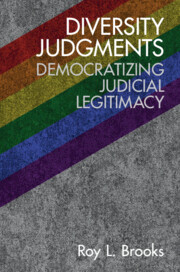Book contents
- Diversity Judgments
- Diversity Judgments
- Copyright page
- Dedication
- Contents
- Preface
- Acknowledgments
- Introduction
- Part I Asian Americans
- Part II African Americans
- Part III Women
- Part IV Latinx
- Part V Native Americans
- Part VI LGBTQ
- 14 Obergefell v. Hodges (Same-Sex Marriages)
- 15 Bostock v. Clayton County (Employment Discrimination)
- Part VII Intersectionality
- Part VIII Outsiders v. Outsiders
- Part IX White Males
- Part X Situational Outsiders
- Index
14 - Obergefell v. Hodges (Same-Sex Marriages)
from Part VI - LGBTQ
Published online by Cambridge University Press: 10 March 2022
- Diversity Judgments
- Diversity Judgments
- Copyright page
- Dedication
- Contents
- Preface
- Acknowledgments
- Introduction
- Part I Asian Americans
- Part II African Americans
- Part III Women
- Part IV Latinx
- Part V Native Americans
- Part VI LGBTQ
- 14 Obergefell v. Hodges (Same-Sex Marriages)
- 15 Bostock v. Clayton County (Employment Discrimination)
- Part VII Intersectionality
- Part VIII Outsiders v. Outsiders
- Part IX White Males
- Part X Situational Outsiders
- Index
Summary
The institution of marriage has existed for millennia across civilizations. For the great majority of this time, marriage has been defined in terms of only one type of relationship – the union of one man and one woman. Marriage between a man and a woman was believed to be “essential to the very definition of that term and its role and function throughout the history of civilization.” This singular understanding of marriage has prevailed in the United States throughout our history. Indeed, at the time of the nation’s founding, marriage was understood to be a voluntary contract between a man and a woman. The framers drew heavily on legal scholars like William Blackstone, who regarded marriage between “husband and wife” as one of the “great relations in private life,” and philosophers like John Locke, who described marriage as “a voluntary compact between man and woman” centered on “its chief end, procreation” and the “nourishment and support” of children. To the drafters of the Constitution, this conception of marriage and family “was a given: its structure, its stability, roles, and values accepted by all.”
- Type
- Chapter
- Information
- Diversity JudgmentsDemocratizing Judicial Legitimacy, pp. 325 - 344Publisher: Cambridge University PressPrint publication year: 2022

